Research Highlights Archive
2017 Research Highlights
12.20.2017 Amir Hoveyda: "Synthesis of E- and Z-trisubstituted alkenes by catalytic cross-metathesis"
02.06.2017 Shih-Yuan Liu: “Graphene-like Boron-Carbon-Nitrogen Monolayers”
01.23.2017 Amir Hoveyda: “Molybdenum chloride catalysts for Z-selective olefin metathesis reactions”
01.09.2017 Amir Hoveyda: “Kinetically E-selective macrocyclic ring-closing metathesis”
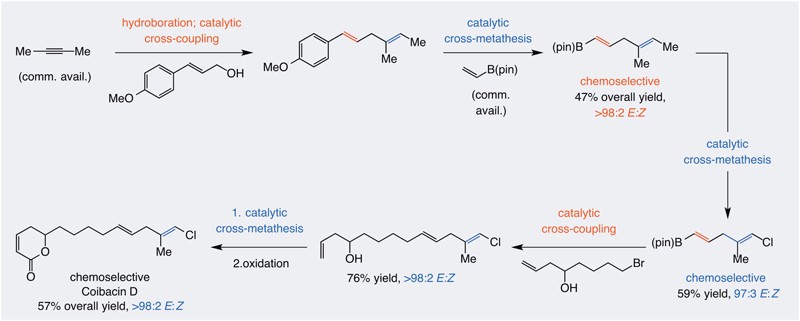
Catalytic cross-metathesis is a central transformation in chemistry, and yet, related methods for stereoselectively generating acyclic trisubstituted alkenes in either isomeric form have been non-existent. The key problems are lack of chemoselectivity, namely, the preponderance of side reactions involving only the less hindered starting alkene, ensuing nonproductive processes of homo-metathesis byproducts, and formation of short-lived methylidene complexes. In contrast, in catalytic cross‐coupling, another widely used process, substrates are more distinct and homocoupling is less of a problem. In a recent Article published in Nature this week (DOI:10.1038/nature25002), Professor Amir Hoveyda and graduate students Thach Nguyen, Min Joo Koh and Tyler Mann show that through cross-metathesis reactions involving E- or a Z-trisubstituted alkenes, easily prepared from commercially available starting materials by crosscoupling processes, many otherwise desirable and difficult-to- access linear E- or Z-trisubstituted alkenes can be synthesized efficiently and in exceptional stereoisomeric purity (up to >98% E or 95% Z). The BC team highlights the utility of their new advance through concise stereoselective syntheses of biologically active compounds such as indiacen B (anti-fungal) and coibacin D (anti-inflammatory). This work is part of a twenty-year long collaboration with Professor Richard Schrock at MIT and is funded by the NIH.
Read the article in Nature
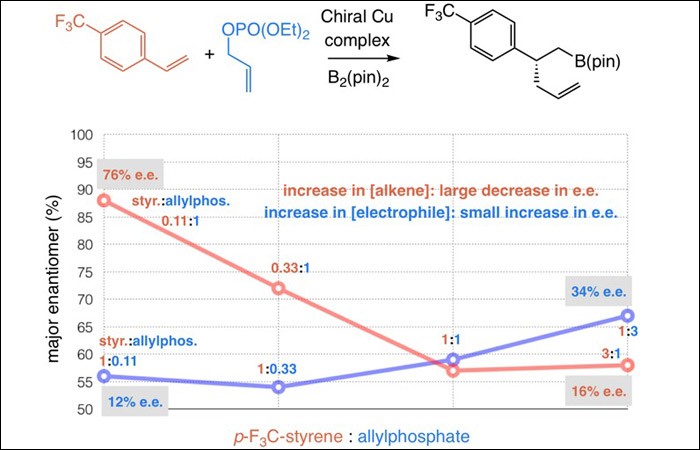
A rapidly emerging set of catalytic reactions involves intermediates that contain a copper-substituted stereogenic carbon centre. In a paper published in Nature Chemistry (DOI: 10.1038/NCHEM.2861), Professor Amir Hoveyda and four members of his team, graduate students Jaehee Lee and Benz Radomkit (now a scientist at Boehringer-Ingelheim), senior research associate Dr. Sebastian Torker and postdoctoral fellow Dr. Juan del Pozo, demonstrate that intimate understanding of this distinction provides ways for addressing limitations in reaction scope and explaining why unexpected variations in enantioselectivity often occur. By using catalytic enantioselective Cu–boryl addition to alkenes as the model process, the Boston College Chemistry team has been able to elucidate several key mechanistic principles. We show that higher electrophile concentration can lead to elevated enantioselectivity; this is because diastereoselective Cu–H elimination may be avoided and/or achiral Cu–boryl intermediates can be converted to allyl–B(pin) rather than add to an alkene. Professor Hoveyda and his colleagues further illustrate that lower alkene amounts and/or higher chiral ligand concentration can minimize the deleterious influence of achiral Cu–alkyl species, resulting in improved enantiomeric ratios. Moreover, and surprisingly, it has been discovered that enantioselectivities are higher with the less reactive allylphenyl carbonates as chemoselective copper–hydride elimination is faster with an achiral Cu-alkyl species. The research was funded by the National Institutes of Health (grant GM-47480), the National Science Foundation (grant CHE-1362763), and Alfonso Martin Escudero Foundation in the form of a postdoctoral fellowship to Dr. del Pozo.
Read the article in Nature Chemistry
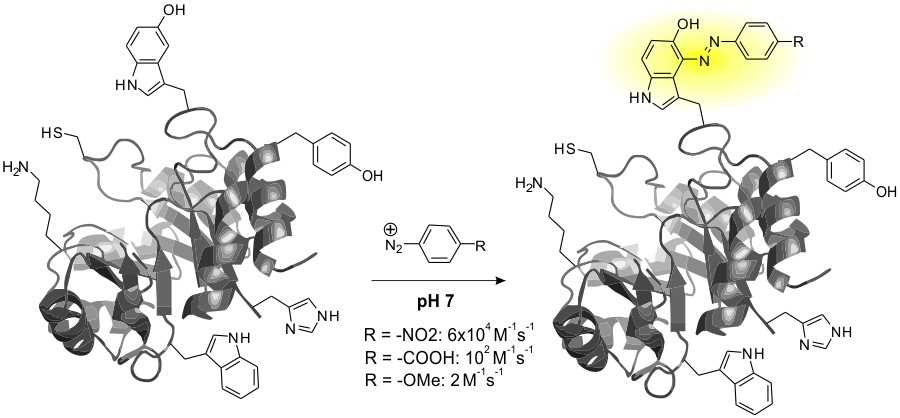
Chemoselective modification of complex biomolecules has emerged as a powerful strategy to investigate and manipulate their structure and function. Despite recent advances in the development of such chemoselective labeling reactions, new reactions are continually sought to enable precise, controllable labeling of multiple sites in tandem. The laboratory of Prof. Abhishek Chatterjee, led by the postdoctoral scholar Partha Sarathi Addy and graduate student James Italia, have now developed a chemoselective rapid azo-coupling reaction (CRACR) that takes advantage of the remarkably rapid reaction between 5-hydroxyindole and aromatic diazonium ions. Furthermore, the Chatterjee lab have genetically encoded the noncanonical amino acid 5-hydroxytryptophan, enabling the site-specific incorporation of the 5-hydroxyindole group virtually into any protein, followed by its selective modification through CRACR. A unique aspect of this conjugation strategy is that the azo-linkage forged using CRACR can be selectively cleaved using dithionite, providing a means to remove the tag. CRACR should also be compatible with currently available conjugation strategies (e.g., the azide-alkyne click reaction), enabling concurrent multi-site directed protein labeling.
Read the article in Journal of the American Chemical Society
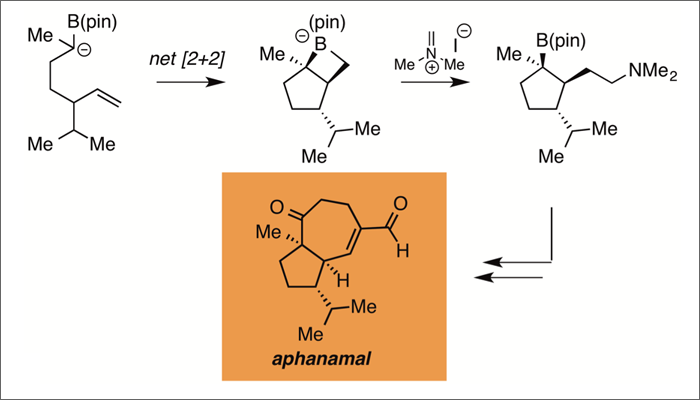
While anionic carbon atoms react with polarized organic functional groups (carbonyls, alkyl halides, etc.) they are generally unreactive with non-polarized functional groups such as isolated alkenes. Despite this reacitivity pattern, a recent report in Angewandte Chemie International Edition(doi: 10.1002/anie.201705720) by Professor James Morken, together with graduate students Xun Liu and Max Deaton, as well as Professor Fredrik Haeffner, describes reactions between α-boryl carbanions and simple olefins. They overall reaction that results is a net [2+2] cycloaddition reaction that furnishes of cyclic four-membered boracycle. This process facilitates the stereoselective construction of substituted cyclopentanes, a feature that the team employed in the stereoselective construction of the natural product aphanmal.
Read the article in Angewandte Chemie International Edition
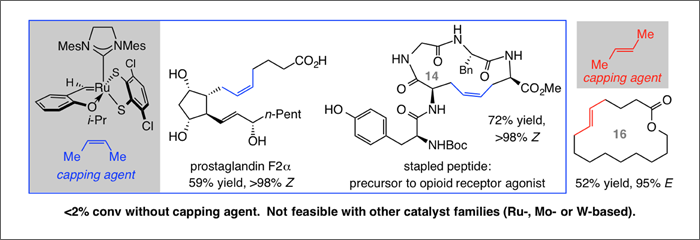
A hallmark of Ru-based olefin metathesis catalysts, which have been pivotal to the emergence of this central transformation, is their ability to promote reactions of hindered alkenes and in the presence of commonly occurring polar functional units such as a neighboring alcohol, an aldehyde, or a carboxylic acid. In 2011, Professor Grubbs and co-workers at California Institute of Technology reported that kinetic control of Zselectivity can be achieved with Ru catalysts by substituting anionic chlorides with an alkyl and an oxo ligand. In 2013, Professor Amir Hoveyda and co-workers outlined the design of a distinct set of Ru-based complexes that contain a key a bidentate disulfide ligand and may be used for efficient catalytic Z-selective olefin metathesis. The CalTech catalysts have proven to be inefficient in promoting transformations with aryl-substituted or hindered terminal olefins and/or when an aldehyde is present, and their activity is entirely inhibited by a carboxylic acid. The BC catalysts, on the other hand, tolerate such functional groups. Nonetheless, the derived methylidene species decompose too rapidly and reactions involving terminal alkenes, the most accessible substrate class, are low yielding.
In a paper that just appeared in the Journal of the American Chemical Society (DOI:10.1021/jacs.7b06552), Professor Hoveyda and graduate student Chaofan Xu and postdoctoral fellow Dr. Xiao Shen demonstrate that by adding Z-butene to a reaction mixture that contains an appropriate Ru dithiolate catalyst, methylidene complex formation can be avoided, and, as a result, an unprecedented range of terminal alkenes may be converted to the desired products by efficient and exceptionally Z- or E-selective cross-metathesis and macrocyclic ring-closing metathesis processes. The BC group reports that stereoselectivity is generally higher when the methylene capping strategy is adopted. The broad applicability and general utility of the approach is highlighted by concise (i.e., little or no protection/deptrotection sequences) and stereoselective syntheses of a platelet aggregate inhibitor, prostaglandins E2 and F2α as well as a fourteen-membered ring stapled peptide that is precursor to a potent opioid receptor agonist.
Read the article in Journal of the American Chemical Society

There are a great number of biologically active organic molecules that contain one or more N-containing moieties and broadly applicable and efficient catalytic transformations that deliver them diastereo- and/or enantioselectively are in much demand. A variety of methods for enantioselective synthesis of α-secondary amines are available (e.g., from additions to protected/activated aldimines), but those involving ketimines are much less common. There are no known examples regarding additions of carbon-based nucleophiles to unprotected/unactivated (or N-H) ketimines. In a recent report published in Nature Chemistry (AOP; DOI: 10.1038/NCHEM.2816), Professor Amir Hoveyda together with graduate student Hwanjong Jang, postdoctoral fellow Dr. Filippo Romiti, and senior research associate, Dr. Sebastian Torker, report on a catalytic transformation that allows for diastereo- and enantioselective three-component merging of an N-H ketimine, a monosubstituted allene and B2(pin)2. The desired products were isolated in up to 95% yield, >98% diastereoselectivity and >99:1 enantiomeric ratio. Utility of the approach was demonstrated by synthesis of the tricyclic core of a class of compounds that have been shown to possess anti-Alzheimer activity. Stereochemical models, developed with the aid of DFT calculations, are also presented in this paper, accounting for the trends and levels of enantioselectivity are presented.
Read the article in Nature Chemistry
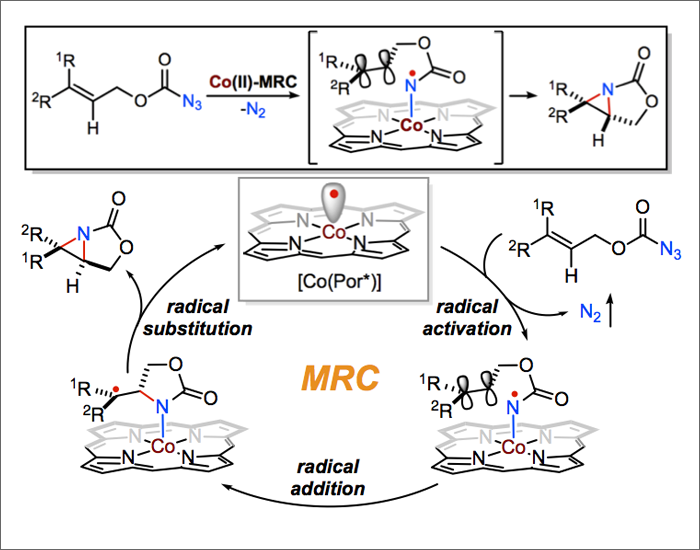
Catalytic intramolecular aziridination of alkenes represents one of the most attractive approaches for the construction of fused bicyclic aziridines. While diastereoselective reactions have been developed, there is no effective catalytic system that is capable of asymmetric intramolecular aziridination of alkenes. The research laboratory of Professor Peter Zhang, led by postdoctoral associates Kai Lang and Huiling Jiang, recently reports a fundamentally new approach based on the concept of metalloradical catalysis (MRC) to address this long-standing challenge via well-controlled stereoselective radical chemistry. They have developed a Co(II)-based metalloradical system that, for the first time, can effectively catalyze asymmetric intramolecular aziridination of allyl azidoformates through a stepwise radical bicyclization pathway without the need of bases or oxidants. Using D2-symmetric chiral amidoporphyrin as the ligand, the Co(II)-catalyzed process allows for efficient construction of 3-oxa-1-azabicyclo[3.1.0]hexan-2-one structures in high yields with excellent diastereoselectivity and enantioselectivity. The resulting optically active bicyclic aziridines can serve as useful intermediates for the preparation of chiral oxazolidinone and vicinal amino alcohol derivatives with retention of the original enantiopurity.
Read the article in Journal of the American Chemical Society
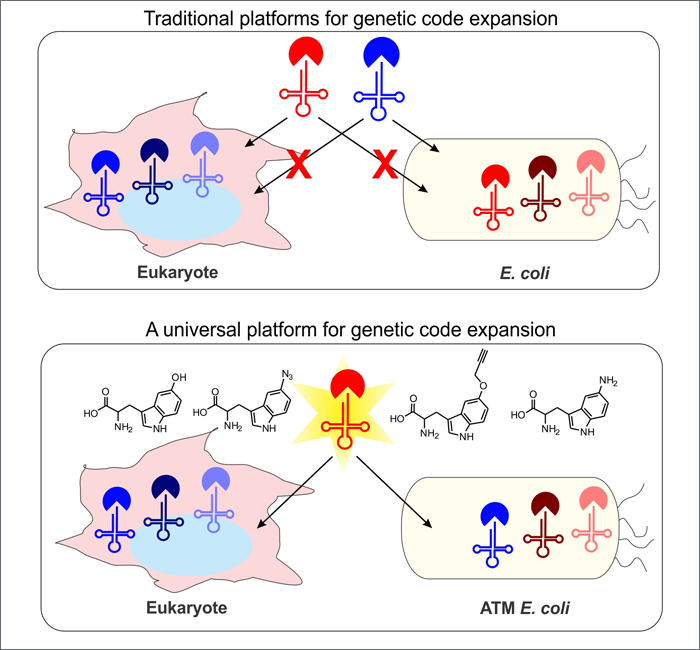
In all domains of life, proteins are composed of the different combinations of the same 20 amino acids. The ability to site-specifically introduce unnatural amino acids with enabling chemical functionalities provides a powerful way to both probe and engineer protein function. Using engineered aminoacyl-tRNA synthetase (aaRS)/tRNA pairs, it has been possible to site-specifically incorporate unnatural amino acids into proteins in living cells. However, in the current paradigm of this technology, two distinct sets of aaRS/tRNA pairs are needed for application in bacterial and eukaryotic cells. Furthermore, engineering the aaRS/tRNA pairs compatible with eukaryotic cells has been significantly more challenging, limiting the scope of this technology. To overcome these limitations, Assistant Professor Abhishek Chatterjee, graduate student James Italia, and coworkers have developed a strategy to create an aaRS/tRNA pair capable of driving unnatural amino acid incorporation in both bacterial and eukaryotic cells. The ability to rapidly engineer this pair enabled incorporation of several new unnatural amino acids in both E. coli and human cells, including those harboring functionalities that allow bioorthogonal chemical conjugation reactions. The general nature of this strategy will further facilitate the development of additional aaRS/tRNA pairs with the same advantage, substantially expanding the palette of new chemistries that can be site-specifically incorporated into proteins.
Read the article in Nature Chemical Biology

New strategies for enantioselective construction of common functional group motifs under mild conditions are important tools for chemical synthesis. In a recent communication appearing in the Journal of the American Chemical Society, Professor Masayuki Wasa and his colleagues Ming Shang, Xiaoxu Wang, Seung Moh Koo, Jennifer Youn, Jessica Chan, Wenzhi Yao and Brian Hastings have described a new method for the direct enantioselective amination reaction through the judicious design of a catalyst that comprises a frustrated Lewis acid/Brønsted base pair. The two components of the catalyst system conspire to facilitate enolization of simple carbonyls, and then serve to activate nitrogen-based electrophiles for enantiodetermining nucleophilic addition of the enolate. The resulting α-amino carbonyl compounds are important motifs in many pharmaceuticals and materials, and the advance from the Wasa lab provides a new method for their direct asymmetric synthesis.
Read the article in Journal of the American Chemical Society
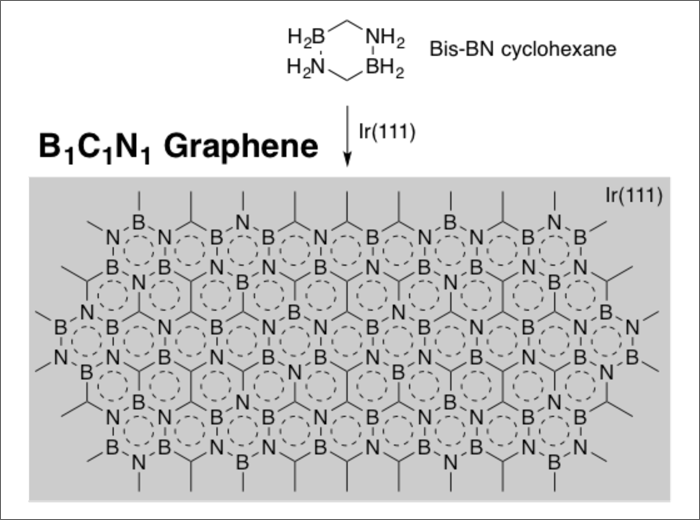
Graphene, a single layer of carbon in a honeycomb structure, has received significant attention as a material with unique mechanical and optoelectronic properties. Graphene is a zero-band-gap semiconductor, thus the absence of a band gap has limited its use in 2D electronics. On the other end of the spectrum, hexagonal boron-nitride (h-BN), the boron-nitrogen (BN) derivative of graphene, is a wide-band-gap insulator (~5.7 eV band gap). To achieve a useful band gap of 1 – 2 eV, the synthesis of BN-doped graphene has been proposed. Despite significant efforts that have delivered among others edge-modified graphene, phase-separated graphene and h-BN islands within a 2D sheet, a homogeneously distributed h-CBN graphene with a well-defined stoichiometry has remained elusive.
In their recent article from ACS Nano (published online; DOI: 10.1021/acsnano.6b08136), Professor Shih-Yuan Liu and his collaborators demonstrate that h-C1B1N1 graphene can be grown on an Ir(111) surface using bis-BN cyclohexane, a small molecule precursor with a 1:1:1 B:C:N stoichiometry that has been developed in the Liu lab in 2014. Solid-state materials characterization using scanning tunneling microscopy (STM), X-ray photoelectron spectroscopy (XPS), low-energy electron diffraction (LEED) coupled with computational modeling are consistent with the proposed structure. A band gap of 1.50 eV has been predicted for the proposed structure that is derived from initial dehydro-coupling of BN bonds followed by dehydro-coupling to form C-X (X = B, N) bonds.
Overall, this work demonstrates that the use of stoichiometrically precise BN heterocycle molecules can translate into structurally well-defined extended 2D materials with good control of elemental stoichiometry and bond connectivity in a bottom-up synthetic strategy.
View the publication in ACS Nano
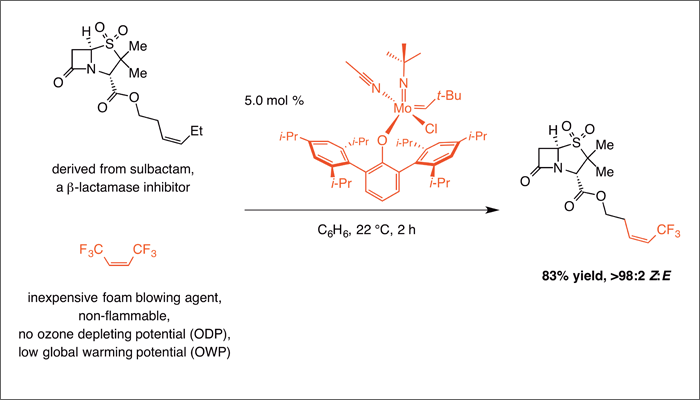
A transformative advance in chemistry has been the development of catalyst-controlled stereoselective olefin metathesis reactions; the original discovery, disclosed in 2009, and many of the subsequent related breakthroughs have been the result of research carried out in the laboratories of Professor Amir Hoveyda. During the past eight years the BC team has shown that incorporation of appropriate ligands within molybdenum-, tungsten (in collaboration with Professor Richard Schrock and co-workers at MIT) as well as ruthenium-based complexes has made formerly inaccessible reactivity and selectivity levels feasible. Now, graduate students Ming Joo Koh and Thach Nguyen and senior research fellow, Dr. Sebastian Torker, from the Hoveyda group together with postdoctoral fellows Dr. Jonathan Lam and Dr. Jakob Hyvl of the Schrock laboratories report in a Letter published in Nature (doi:10.1038/nature21043). that molybdenum monoaryloxide chloride (MAC) complexes furnish higher energy Z isomers of trifluoromethyl-substituted alkenes through cross-metathesis with commercially available, inexpensive and typically inert Z-1,1,1,4,4,4-hexafluoro-2-butene. The latter reagent is an inexpensive, non-flammable widely used commercially as foam blowing agent and; additionally, it has zero ozone depleting potential and minimal global warming potential. Otherwise inefficient and non-stereoselective transformations with Z-1,2-dichloro- and 1,2- dibromoethene can also be effected with substantially improved efficiency and Zselectivity. The importance of the new advance is highlighted through synthesis of representative biologically active molecules and trifluoromethyl analogues of medicinally relevant compounds. With the aid of DFT calculations, a logical basis for the origins of activity and selectivity levels, which contradict the previously proposed principles, has been provided.
Read the article in Nature
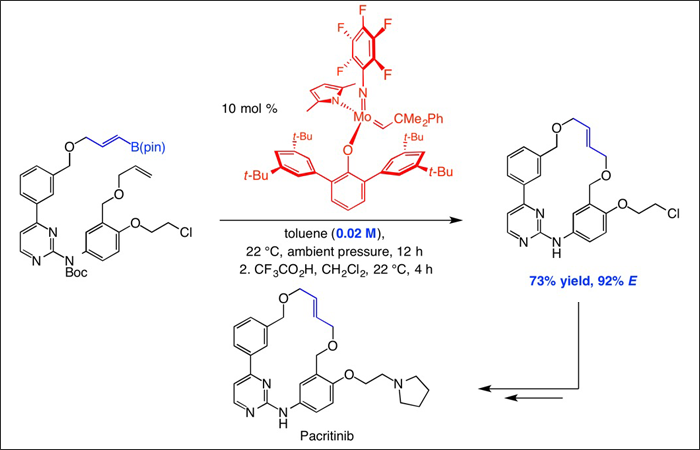
Macrocyclic organic molecules are central to discovery of new drugs but their preparation is often challenging because of the energy barrier required for bringing together and fusing the two ends of an acyclic precursor. Ring-closing metathesis (RCM) is a widely used catalytic process that has allowed access to countless biologically active macrocyclic organic molecules even on large scale (up to 200 kilograms). The potency of a macrocyclic compound can depend on the stereochemistry of its alkene, or one isomer might be needed for subsequent stereoselective modification (e.g., dihydroxylation). Professor Amir Hoveyda and his research group reported in a paper in Nature in 2011 the discovery of kinetically controlled Z-selective RCM. However, a generally applicable kinetically E-selective strategy has remained elusive until now. In a new paper just published by the journal Nature (doi:10.1038/nature 20800), the same research group at Boston College chemistry department show that dienes containing an E-alkenyl–B(pinacolato) group, widely used in catalytic cross-coupling, possess the requisite electronic and steric attributes to allow them to be converted stereoselectively to E macrocyclic alkenes. The team, which includes postdoctoral fellows Dr. Xiao Shen(soon to join the faculty at Wuhan University in China) and Dr. Alex Speed (now a faculty member at Dalhousie University in Canada), graduate students Thach Nguyen and Ming-Joo Koh and undergraduate scholar Dongmin Xu, finds that reactions can be promoted by a molybdenum monoaryloxide pyrrolide complex and afford products in up to 73 percent yield and >98:2 E:Z ratio. Utility is highlighted by application to preparation of the eighteen-membered ring Janus kinase 2/Fms-like tyrosine kinase-3 (JAK2/FLT3) inhibitor pacritinib the Z isomer of which has lower potency than the E. The eighteen-membered ring moiety of pacritinib, a potent in vivo anti-cancer agent in advanced clinical trials for treatment of lymphoma and myelofibrosis, was prepared by an RCM carried out at 20 times higher concentration than when a ruthenium carbene was employed. This study is part of a 20-year old collaboration between the Hoveyda group and the research team of Professor Richard Schrock at MIT.
Read the article in Nature
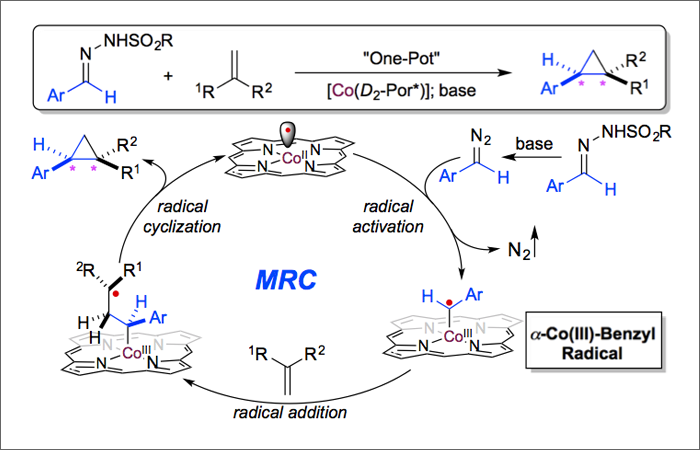
Catalytic asymmetric cyclopropanation of alkenes with diazo reagents is one of the most important chemical transformations in organic synthesis. It allows for stereoselective construction of optically active three-membered carbocycles, which have found a myriad of fundamental and practical applications. While several types of diazo reagents have been successfully used for the catalytic process, asymmetric cyclopropanation with donor-substituted diazo reagents has been much less developed. To date, there is no effective catalytic system that is capable of direct asymmetric cyclopropanation of alkenes with donor-substituted diazo reagents. The research laboratory of Professor Peter Zhang, led by graduate students Yong Wang and Xin Wen, recently reports a fundamentally new approach based on the concept of metalloradical catalysis (MRC) to address this long-standing challenge via well-controlled stereoselective radical chemistry. They have developed a Co(II)-based metalloradical system that, for the first time, can effectively catalyze asymmetric cyclopropanation of alkenes with donor-substituted diazo reagents, generated in suit from N-arylsulfonyl hydrazones in the presence of base. The Co(II)-catalyzed radical cyclopropanation can be operated under mild conditions and is applicable to a broad combination of N-arylsulfonyl hydrazones and alkenes, affording 1,2-bisaryl and related cyclopropane compounds in high yields with effective control of both diastereoselectivity and enantioselectivity. Among other attributes, the Co(II)-based cyclopropanation is highlighted by its high degree of functional group tolerance, a feature that is closely related to its underlying radical mechanism.
Read the article in Journal of the American Chemical Society
2016 Research Highlights
10.04.2016 Dunwei Wang: “A rechargeable non-aqueous Mg-Br2 battery”
08.01.2016 Amir H. Hoveyda: “Catalytic enantioselective 1,6-conjugate additions of propargyl and allyl groups”
04.29.2016 Amir H. Hoveyda: “Kinetically Controlled E-Selective Catalytic Olefin Metathesis”
03.27.2016 Amir H. Hoveyda: “Direct synthesis of Z-alkenyl halides through catalytic cross-metathesis”
02.18.2016 Lawrence T. Scott: “Chiral shape induction in achiral crystals by a chiral hemifullerene”
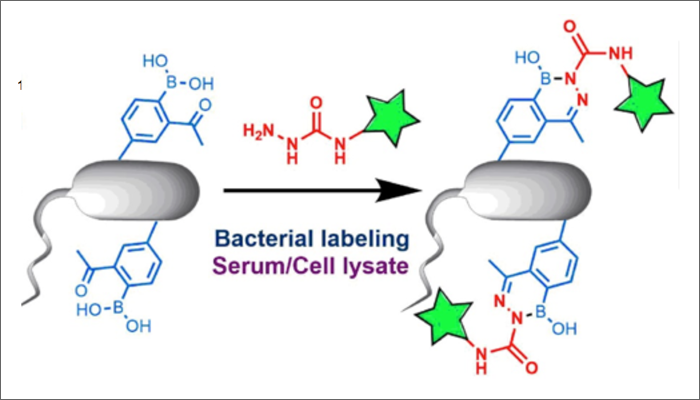
An Ideal Bioorthogonal Conjugation
Conjugation reactions that readily proceed in biological milieu prove to be powerful tools in biological research. An ideal bioorthogonal reaction is expected to show fast kinetics, high stability, little toxicity, and lack of interference by endogenous biomolecules. Writing in the Journal of American Chemical Society, Associate Professor Jianmin Gao along with his group members Dr. Anupam Bandyopadhyay and Samantha Cambray describe such a bioorthogonal conjugation reaction, which the authors developed to facilitate detection of pathogenic bacteria in blood serum. The conjugation chemistry takes advantage the unique reactivity of semicarbazide, which readily reacts with 2-formyl or 2-acetylphenylboronic acid to give stable diazaborines. The diazaborine formation proceeds with rate constants over 1,000 M-1 s-1 under physiologic conditions and is essentially unaffected by the presence of blood serum or cell lysate. The team further reports that a synthetic amino acid incorporating the 2-acetylphenylboronic acid moiety can efficiently remodel the cell wall of important bacterial pathogens, thus yielding a convenient handle for their labeling and detection with semicarbazide-based reagents (see illustration above). Although the current work focuses on bacterial detection, this bioorthogonal conjugation reaction should be applicable to a wide range of biological problems.
Read the article in Journal of the American Chemical Society
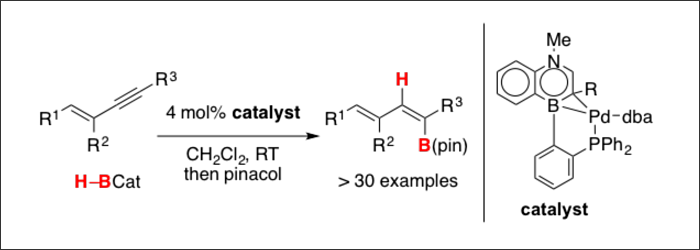
BN/CC isosterism has been demonstrated to be a viable strategy to expand the chemical space of organic compounds. While progress has been made in applying the BN/CC isosterism approach to achieve new properties and functions in biomedical and materials research, it has not been effectively utilized in ligand-supported catalysis. This is surprising in view of tremendous opportunities for achieving new reactivity and selectivity in catalytic transformations that the electronic tuning through BN/CC isosterism could potentially provide. In their recent communication from the Journal of the American Chemical Society (published online; http://pubs.acs.org/doi/abs/10.1021/jacs.6b09759), Professor Shih-Yuan Liu and his coworkers Dr. Senmiao Xu and Yuanzhe Zhang demonstrate that 1,4-azaborine-based phosphine (Senphos) ligands can uniquely support the Pd-catalyzed trans-hydroboration of both terminal and internal enynes. To date only a handful of metal-catalyzed systems have been demonstrated to achieve trans-hydroboration of alkynes (mostly terminal alkynes), and their work represents the first metal-catalyzed system that can achieve the trans-hydroboration of internal enynes. The resulting dienylboronates are useful intermediates in organic synthesis. X-ray structural analysis of the Senphos-Pd(0) complex reveals a κ2-P-η2-BC coordination mode, and this isolated complex has been shown to serve as a competent catalyst for the trans-hydroboration reaction. Overall, this work demonstrates that the expanded chemical space provided by the BN/CC isosterism approach translates into the functional space in the context of stereoselective catalytic transformations.
Read the article in Journal of the American Chemical Society
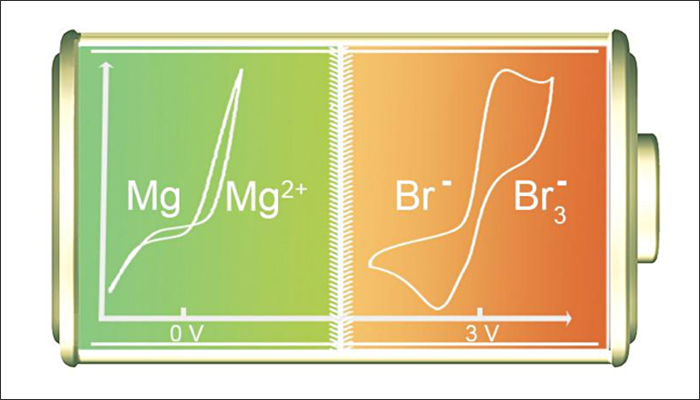
Mg metal has long been considered the most promising anode material for the energy storage systems beyond Li-ion batteries. Its merits come from the nearly 2 times higher high volumetric energy density than Li metal, significantly improved safety promise and earth abundance. However, the realization of Mg metal battery has been limited by the lack of proper intercalation cathode materials, due to the sluggish Mg2+diffusion in most solids. To address this challenge, Associate Professor Dunwei Wang and his team broke the constraint of the solid cathode and demonstrate conversion chemistry of Br2/Br- in solution with fast kinetics and high energy density. Because of the known reactivity between Br2 and most organic solvents, prior Br2 cathode studies were limited to aqueous systems, making it difficult to utilize Mg metal as the anode. The problem is solved by the introduction of a dual electrolyte system. For the anode, a dimethoxyethane and bis(2-methoxyethyl) ether mixture is used, which is compatible with Mg. For the cathode, an ionic liquid (1-butyl-1-methylpyrrolidinium bis(trifluoromethanesulfonyl)imide) with excessive Br- as stabilizing agent is used. Together, this system enables a prototypical rechargeable non-aqueous Mg-Br2 battery for the first time. A nominal operational voltage of 3.0 V, specific energy density of 290 mAh/gMgBr2, Coulombic efficiency over 96% and lifetime of more than 20 fully discharge/charge cycles are achieved. The electrochemical and diffusion behavior are also further studied in depth to provide better understanding of the system for future improvement. The results introduce a new energy storage route toward low-cost, high-capacity and safe batteries.
Read the article in Nano Energy
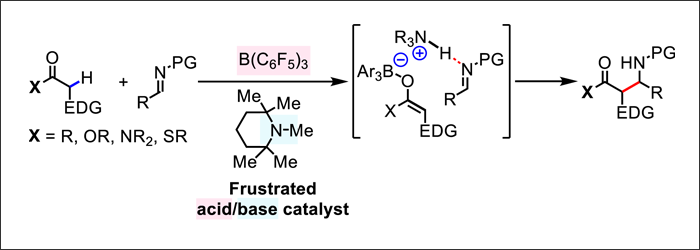
New strategies for construction of common functional group motifs under mild conditions are important tools for chemical synthesis. In a recent communication appearing in Angewandte Chemie International Edition, Professor Masayuki Wasa and his colleagues Jessica Chan, Wenzhi Yao, ;Brian Hastings, and ;Charles Lok have described a new method for the direct Mannich-type reaction through the judicious design of a catalyst that comprises a frustrated Lewis acid/Brønsted base pair. The two components of the catalyst system conspire to facilitate enolization of simple carbonyls, and then serve to activate imine electrophiles for nucleophilic addition of the enolate. The resulting β-amino acids products are important features in many pharmaceuticals and materials, and the advance from the Wasa lab provides a new paradigm for their stereoselective synthesis.
Read the article in Angewandte Chemie International Edition
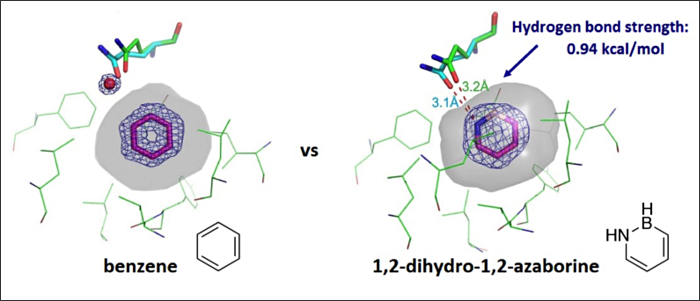
Aromatic rings are ubiquitous in medicinal chemistry, and arene-containing compounds prevail among top-selling small-molecule drugs. Azaborine heterocycles, which are boron-nitrogen-containing isosteres of arenes, have the potential to expand the chemical space of arenes and lead to novel pharmacological activity. In their recent communication from the Journal of the American Chemical Society (published online; DOI: 10.1021/jacs.6b06566) entitled “Hydrogen Bonding of 1,2-Azaborines in the Binding Cavity of T4 Lysozyme Mutants: Structures and Thermodynamics”, Professor Shih-Yuan Liu and his graduate student, Hyelee Lee at Boston College, in collaboration with the group of Professor Brian Shoichet at University of California, San Francisco demonstrate the effect of BN/CC isosterism on recognition in aryl binding pockets and on the hydrogen-bonding capability of NH-containing 1,2-azaborines via a systematic quantitative study. Using high-resolution protein X-ray crystallography, a Gln102=O···H–N hydrogen bond was observed in the complexes of 1,2-azaborine in a polar binding model pocket of a T4 lysozyme mutant (L99A/M102Q). Using isothermal titration calorimetry and thermodynamic cycle analysis, the strength of the hydrogen bonding was determined to be 0.94 kcal/mol.
This work unambiguously demonstrates that 1,2- azaborines can be readily accommodated in classic aryl recognition pockets and establishes one of 1,2- azaborine’s distinguishing features from arenes, i.e., its ability to serve as a NH hydrogen bond donor in a biological setting. The quantitative structural and thermodynamic binding data that has emerged from this work will also serve as general reference for future biomedical work on 1,2-azaborines.
Read the article in Journal of the American Chemical Society

As the newest application of metalloradical catalysis (MRC) for development of stereoselective radical processes for organic synthesis, Professor Peter Zhang and coworkers has recently reported an Co(II)-based new catalytic system for intramolecular radical aziridination of allylic sulfamoyl azides. The Co(II)-catalyzed radical aziridination provides the first synthetic tool for effective construction of the highly strained 2-sulfonyl-1,3-diazabicyclo[3.1.0]-hexane structures. The Co(II)-based MRC system, which operates under neutral and nonoxidative conditions, is generally applicable to a wide range of allylic sulfamoyl azides, allowing for high- yielding synthesis of the bicyclic aziridine molecules with various substitution patterns. They demonstrate the resulting [3.1.0]-bicyclic aziridines can serve as versatile synthons for preparation of a diverse range of 1,2- and 1,3-diamine derivatives by selective ring-opening reactions in exo- and endo-fashion, respectively. To showcase its application for target synthesis, the metalloradical intramolecular aziridination reaction has been incorporated as a key step for efficient synthesis of a potent neurokinin 1 (NK1) antagonist in 60% overall yield.
Read the article in Angewandte Chemie International Edition
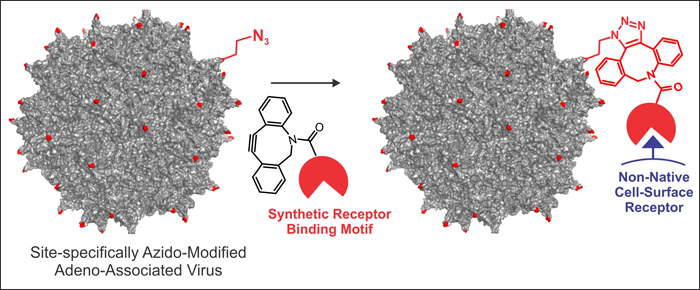
Gene-therapy has the potential to cure many genetic disorders, such as hemophilia, which are not amenable to traditional therapeutic strategies. Viruses represent the most promising candidates for delivering therapeutic genes into desired human cells in vivo. However, the intrinsic preference of a virus to infect a certain subset of human cells is often at odds with the therapeutic need, and the ability to rationally engineer the cell-specificity of a virus is highly desirable. However, the delicate architecture of the virus capsid often thwarts engineering efforts that involve significant structural alterations. To overcome this challenge, the group of Assistant Professor Abhishek Chatterjee has developed a new strategy where adeno-associated virus – one of the most promising candidates for human gene therapy – is first produced incorporating a novel unnatural amino acid into predefined sites of its capsid. Owing to its small size, incorporation of the novel amino acid did not perturb to the delicate virus capsid, and the azido functionality present in its side chain facilitated chemical attachment of synthetic targeting agents that enabled the virus to specifically bind and infect cancer cells. The ability to chemically attach any desired targeting agent to specific sites on the virus capsid provides a powerful, general approach to engineer the infectivity of human viruses to generate safe and effective gene-therapy vectors.
Read the article in Angewandte Chemie
Read the BC News Release
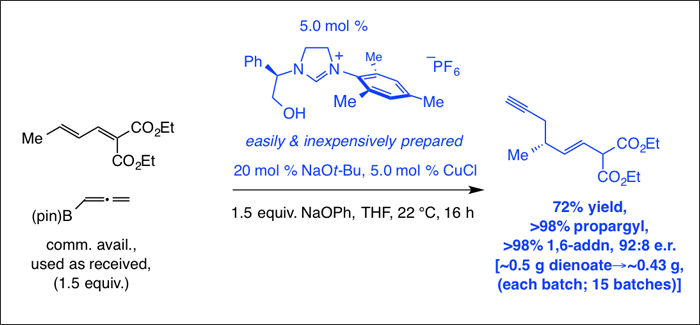
Conjugate (or 1,4-) additions of carbanionic species to α,β-unsaturated carbonyl compounds are vital to research in chemistry and several chiral catalysts that facilitate these transformations have been developed. Catalytic enantioselective 1,6-conjugate additions are uncommon however, and those that incorporate versatile and readily functionalizable moieties, such as propargyl or allyl groups, into acyclic α,β,γ,δ-doubly unsaturated acceptors are unknown. In a recent paper published in the Journal Nature, Professor Amir Hoveyda ;along with postdoctoral fellows Drs. Fanke Meng, Xiben Li, Sebastian Torker, Xiao Shen and graduate student Ms. Ying Shi demonstrate that an easily accessible copper-based catalyst can promote 1,6-conjugate additions of propargyl and 2–boryl-substituted allyl groups to acyclic dienoates with exceptional selectivity. A commercially available allenylboron compound or a monosubstituted allene may be used as starting materials. Products can be isolated in up to 83% yield, >98:2 diastereomeric (for allyl additions) and 98:2 enantiomeric ratio. Mechanistic details, including the origins of high site- (1,6- vs. 1,4-) and enantioselectivity based on the catalyst structure and the reaction type, are elucidated with the help of density functional theory (DFT) calculations. These studies were funded by grants from the National Institutes of Health and the National Science Foundation.
Read the article in Nature
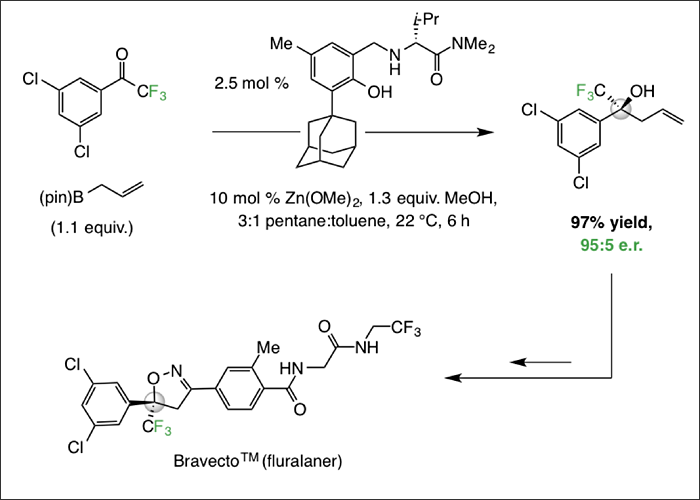
Organofluorine compounds are central to several areas of research and development in modern chemistry. As such, broadly applicable transformations that generate them efficiently and enantioselectively are in high demand. Now in a recent report in the journal Nature Chemistry(published online; DOI: 10.1038/NCHEM.2523) entitled “Catalytic enantioselective addition of organoboron reagents to fluoroketones controlled by electrostatic interactions” by Professor Amir Hoveyda and members of his research group, graduate students KyungA Lee, Daniel Silverio and Farid van der Mei and postdoctoral fellow Dr. Daniel Robbins along with senior research associates Dr. Sebastian Torker and Dr. Fredrik Haeffner, introduce efficient catalytic methods for additions of allyl and allenyl organoboron reagents to fluorine-substituted ketones. These reactions are facilitated by readily and inexpensively available catalysts and deliver versatile and otherwise difficult-to-access tertiary homoallylic alcohols in up to 98% yield and >99:1 enantiomeric ratio. Utility is highlighted by a concise enantioselective approach to synthesis of anti-parasitic drug BravectoTM (presently sold as the racemate by Merck). A crucial fundamental aspect of this investigation is that different forms of ammonium-organofluorine interactions are illustrated to play a key role in controlling enantioselectivity. The greater understanding of various non-bonding interactions afforded by these studies is expected facilitate future development of transformations involving fluoro-organic entities.
Read the article in Nature Chemistry
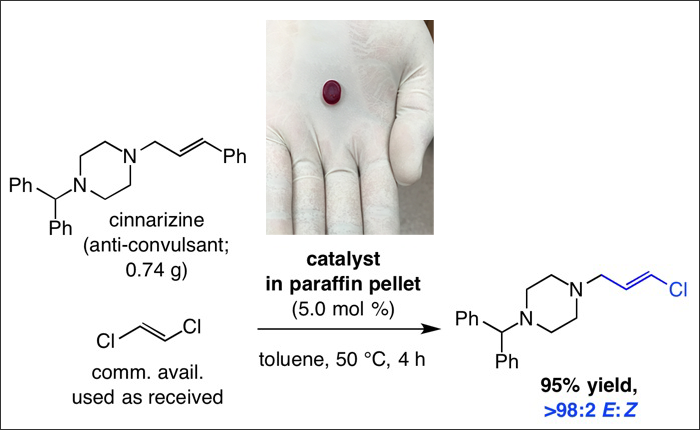
A significant shortcoming in olefin metathesis, a chemical process that is central to research in several branches of chemistry, is the complete lack of efficient methods that kinetically favor E-isomers in the product distribution. Now a team of chemists that includes Professor Amir Hoveyda and graduate students Thach Nguyen and Ming Joo Koh together with postdoctoral fellows Xiao Shen and Filippo Romiti report in a recent issue of the journal Science (2016, 352, 569–575) that kinetically E-selective cross-metathesis reactions may be designed to generate thermodynamically disfavored alkenyl chlorides and fluorides in high yield and with exceptional stereoselectivity. The BC researchers demonstrate that with 1.0–5.0 mol % of a molybdenum-based catalyst, which may be delivered in the form of air- and moisture-stable paraffin pills soon to be commercially available by Aspira, Inc., reactions typically proceed to completion within four hours at ambient temperature. Many isomerically pure E-alkenyl chlorides, applicable to catalytic cross-coupling transformations and found in biologically active entities, thus become easily and directly accessible. Similarly, E-alkenyl fluorides can be synthesized from simpler compounds or more complex molecules. This is the most recent chapter in the nearly two-decade old collaboration between the Hoveyda group and that of Richard Schrock at MIT.
Read the article in Science

Olefin metathesis has had a profound impact on modern chemistry and yet it suffers from important shortcomings. The lack of efficient processes that generate acyclic alkenyl halides is one conspicuous example. In a recent Article in the journal Nature (doi:10.1038/nature17396) Professor Amir H. Hoveyda, two of his doctoral students, Ming Joo Koh and Thach Nguyen along with a postdoctoral associate Dr. Hanmo Zhang provide the first general solution to this important problem. Specifically, they show that hitherto unknown halogen-substituted molybdenum alkylidene species are exceptionally reactive yet appropriately long living and participate in high yielding olefin metathesis reactions that afford acyclic 1,2-disubstituted Z-alkenyl halides. Transformations are promoted by small amounts of an in situ-generated catalyst with unpurified, commercially available and easy-to-handle liquid 1,2-dihaloethene reagents and proceed to high conversion at ambient temperature within four hours. Many alkenyl chlorides, bromides and fluorides can be obtained in high yield and Z selectivity. By syntheses of several biologically active compounds, the Boston College researchers highlight the utility of their new discovery. These studies are part of a long-standing collaboration with Professor Richard Schrock (MIT) and were funded by two grants from the National Institutes of Health. The technology has been licensed by XiMo, AG, a company founded by Professors Hoveyda and Schrock, for various applications in chemical, pharmaceutical and fragrance industry.
Read the article in Nature
Related article: “No double bond left behind” in Nature
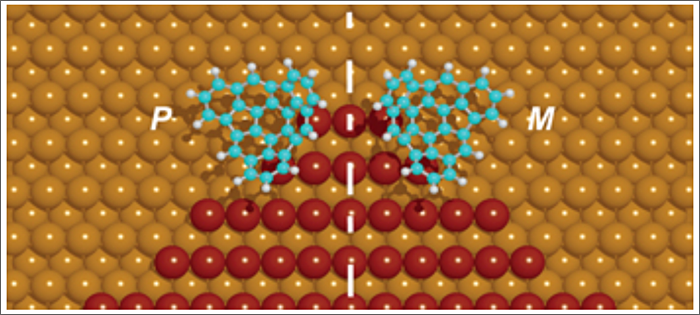
Wende Xiao, Karl-Heinz Ernst, Krisztian Palotas, Yuyang Zhang, Emilie Bruyer, Lingqing Peng, Thomas Greber, Werner A. Hofer, Professor Emeritus Lawrence T. Scott, & Roman Fasel
In biomineralization, inorganic materials are formed with remarkable control over their shape and morphology. In fact, chirality is common not only in the biomolecular world but also among biominerals. When biomacromolecules, such as proteins and polysaccharides, make direct contact with a mineral phase, they often act as modifiers during nucleation and crystal growth. Owing to their homochirality—they exist only as single enantiomers—their handedness is often transferred into the macroscopic shape of the biomineral crystals. The way in which handedness is transmitted into achiral materials, however, is not yet understood at the atomic level. By using the submolecular resolution capability of scanning tunneling microscopy, supported by photoelectron diffraction and density functional theory, we have shown how the chiral footprint of a hemifullerene (a chiral buckybowl that is essentially half of C60) rearranges atoms in its vicinity at step edges on an achiral copper surface into a chiral morphology. We anticipate that such new insight will find its way into materials synthesis techniques.
Read the article in Nature Chemistry
2015 Research Highlights
10.28.2015 Jeffery A. Byers: “Stereoselective catalysis achieved through in situ desymmetrization”
08.25.2015 Udayan Mohanty: “Excess Ion Atmosphere Around RNA”
06.17.2015 Dunwei Wang: “Rust” and “Dirt” for Artificial Photosynthesis”
06.05.2015 Eranthie Weerapana: “Global Monitoring of Cysteine Reactivity in Living Cells”
03.20.2015 Jianmin Gao: “Chasing Bacteria with Covalent Chemistry”
02.13.2015 Dunwei Wang: “Materials for Better Batteries”
01.14.2015 Amir Hoveyda: “High-value alcohols and higher-oxidation-state compounds”
01.07.2015 Shih-Yuan Liu: “Kinetically Stable Chemical Hydrogen Storage Material”
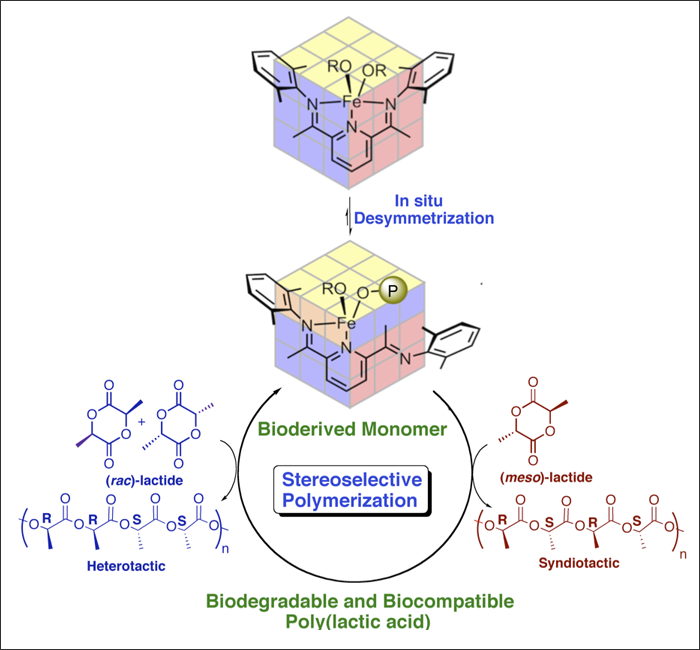
Cesar M. Manna, Aman Kaur, Lauren M. Yablon, Fredrik Haeffner, Bo Li, and Jeffery A. Byers
J. Am. Chem. Soc., Article ASAP, DOI: 10.1021/jacs.5b09966, Publication Date (Web): October 28, 2015
Stereoselective catalysis was performed using achiral iron-based catalyst and silanol additives. The catalytic system was found to control the stereoselective ring-opening polymerization of lactide to form the biodegradable and biocompatible polymer, poly(lactic acid). Precise control over poly(lactic acid) stereoregularity is highly desirable due to its significant effect on polymer physical and mechanical properties as well as on its degradation rate. In addition to the importance in the synthesis of biodegradable polymers, the methodology is the first example that demonstrates stereoselective catalysis achieved through the generation of stereogenic centers generated during the catalytic reaction. This strategy provides an alternative to traditional stereoselective catalytic method that rely on catalyst control. Such methods commonly involve the synthesis and purification of chiral ligands and/or catalysts, which can be laborious and tedious. The method utilized here has no such requirements, which makes it amenable to the rapid screening of catalyst structures from a single iron precursor and simple additives.
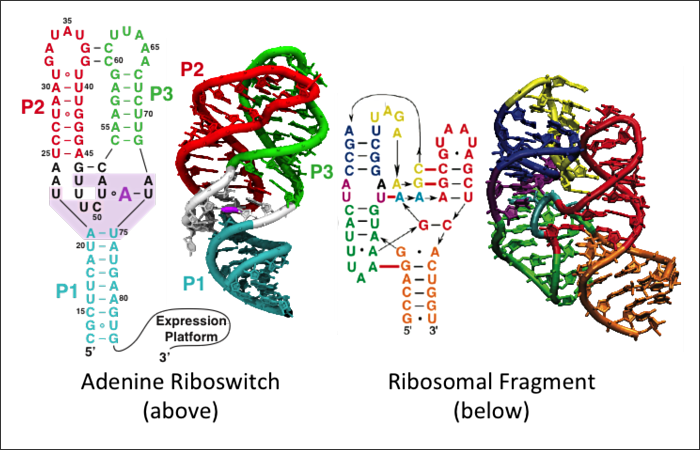
Using statistical mechanics of ionic system, Professor Udayan Mohanty and his collaborators have developed a model that can describe the excess ion atmosphere around any RNA fragment in mixed divalent and monovalent salt solution. They couple the statistical mechanical theory to a coarse-grained potential that allows detailed analysis by molecular dynamics simulations. A key idea is to make monovalent cation condensation a dynamical variable that depends on atomic coordinates and calculated from first principles. This allows them to explore dynamic ensembles rather than only static structures. Their approach goes well beyond mean-field by explicit inclusion of Mg2+-Mg2+, Mg2+-phosphate, and phosphate-phosphate ionic correlations. The model quantitatively describes Mg2+-RNA interactions in adenine riboswitch, a 58 nucleotide ribosomal fragment, and beet western yellow virus pseudoknot, that are in agreement with experimental data of over 7.5 fold [KCl] and several decades of [MgCl2]. This is unprecedented. This model opens up the unique possibility of studying long timescale kinetics of RNAs that fold to complex tertiary structures.
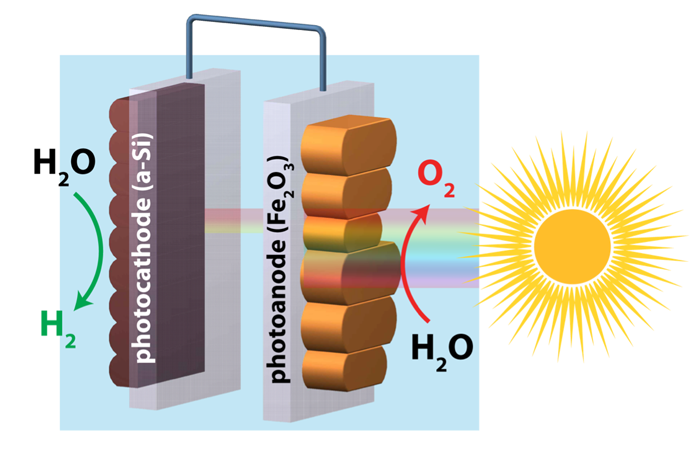
As a close cousin to rust, hematite is the mineral name of alpha phase iron oxide. It possesses a host of properties desired for solar energy harvesting such as stability against photocorrosion, suitable bandgap for maximized energy conversion, and abundance for large-scale implementations. Finding an efficient solar water splitting method to mine electron-rich hydrogen for clean power has been thwarted by the poor performance of hematite, particularly in successfully pumping up the energy of excited electrons. But by “re-growing” the mineral’s surface, a smoother version of hematite more than doubled electrical yield, opening a new door to energy-harvesting artificial photosynthesis, according to a report published online today in the journal Nature Communications by Associate Professor Dunwei Wang and his team.
Re-grown hematite proved to be a better power generating anode, producing a record low turn-on voltage that enabled the researchers to be the first to use earth-abundant hematite and silicon (which is derived from dirt) as the sole light absorbers in artificial photosynthesis. The new hydrogen harvesting process achieved an overall efficiency of .91 percent. The result offers new hope that efficient and inexpensive solar fuel production by readily available natural resources is within reach.
Read the article in Nature Communications
Read the BC News Release
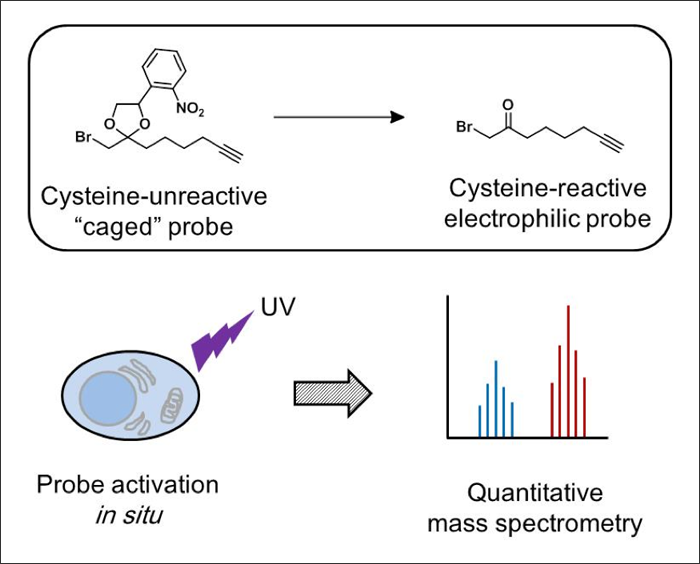
Cysteine residues on proteins are susceptible to an array of posttranslational modifications (PTMs), including oxidation, nitrosation and lipid adduction. Cysteine-reactive chemical probes can be coupled with mass spectrometry (MS) to globally monitor these PTMs and identify the site and stoichiometry of modification. The high reactivity and toxicity of existing cysteine-targeted probes precludes their use in living cells. Many cysteine PTMs are highly labile and are often disrupted by cell lysis, necessitating methods to study these modifications directly within the context of living cells. To globally monitor cysteine reactivity directly in living cells, Assistant Professor Eranthie Weerapana and Postdoctoral Research Associate Masahiro Abo, developed a caged electrophilic probe that can be activated in situ upon irradiation. This caged-bromoketone (BK) probe is non-toxic to cells at high micromolar concentrations and can be activated with both temporal and spatial control upon 5 minutes of UV irradiation. The caged-BK probe was applied to monitor cysteine oxidation events that accompany the activation of cells with growth factors such as the epidermal growth factor (EGF). Binding of EGF to its cognate receptor EGFR generates a burst of hydrogen peroxide, which oxidizes a variety of cellular cysteine residues. Using quantitative MS, cysteine residues known to form redox-active disulfides and sulfenic acids, were found to be oxidized upon cellular EGF stimulation. This platform sets the stage for identifying and quantifying sites of cysteine modification upon treatment with cellular oxidants, cysteine-targeted small-molecule inhibitors and thiophilic metal ions under physiologically relevant conditions.
Read the article in the Journal of the American Chemical Society
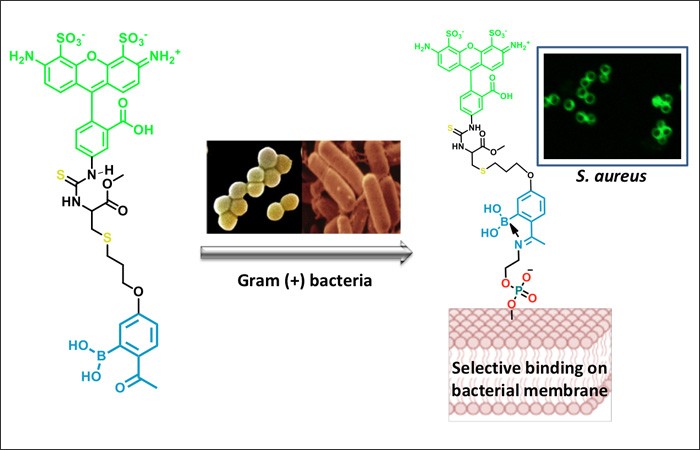
The emergence of pathogenic bacteria that are resistant to conventional antibiotics poses a serious threat to the health of mankind. New diagnostic and therapeutic strategies are needed to combat these bacterial pathogens, for which it is essential to differentiate bacteria from mammalian cells. In their recent article published in Nature Communications, Associate Professor Jianmin Gao and coworkers describe a novel strategy that allows exclusive labeling of bacteria in blood serum. Bacterial cells are known to display a different set of lipids in their membranes in comparison to their mammalian counterparts. Previous work in the field has focused on the use of cationic peptides to target anionic lipids enriched on bacterial cell surfaces. This approach has seen limited success as the charge-charge attraction can be easily weakened by the presence of salt and other biomolecules. The new paper from the Gao group show that certain bacterial lipids, specifically the amine-presenting lipids including phosphatidylethanolamine (PE) and lysyl phosphatidylglycerol (Lys-PG), can be selectively derivatized to form iminoboronates. As amine-presenting lipids are scarce on the surface of mammalian cells, their modification via iminoboronate chemistry allows specific labeling of bacterial cells. Importantly, the iminoboronate formation is quickly reversible under physiologic conditions, which makes it a powerful strategy for targeting biomolecules of interest as modification of unintended targets can be quickly reversed and avoided. Considering the large number of bacterial species that present PE and/or Lys-PG on their surfaces, the covalent labeling strategy reported by Gao and coworkers should find a wide range of applications in diagnosis of bacterial infections and delivery of antibiotic agents.
Read the article in Nature Communications
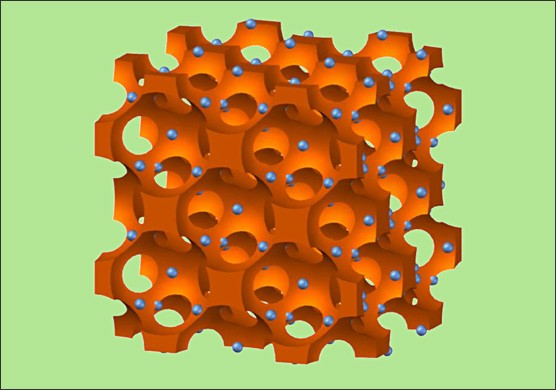
With record-high theoretical capacities, lithium oxygen battery promises a post-Li-ion energy storage technology that may enable electrical vehicles with driving ranges beyond 500 miles. Presently the development of this technology faces a number of challenges, with the poor stability and low charge/discharge efficiency being on the top of the list. These issues are recognized as a result of parasitic reactions between carbon support and the electrolyte with reactive intermediates such as peroxide and superoxide ions. In the summer of 2014, Associate Professor Dunwei Wang’s team demonstrated a strategy to circumvent the stability issue by replacing the current collector with a true carbon-free material of the TiSi2 nanonet (J. Am. Chem. Soc. 2014, 136, 8903). Given the ubiquitous presence of carbon in energy storage devices, its ease of preparation and low cost, however, it is impractical to abandon carbon altogether. Recently, the same team, in collaboration with Assistant Professor Wei Fan of the University of Massachusetts at Amherst, developed a new strategy to address the issue. By coating the carbon surface with a thin but uniform layer of metal oxide using a technique known as atomic layer deposition, the team report in w that the carbon support can be effectively separated from the reactive species. The desired properties of structural support and charge transport by carbon are preserved. As a result, the lifetime of the battery is increased by 325%, while the efficiency is improved by 18%.
Read the article in the Journal of the American Chemical Society
Read the article on the BC News website
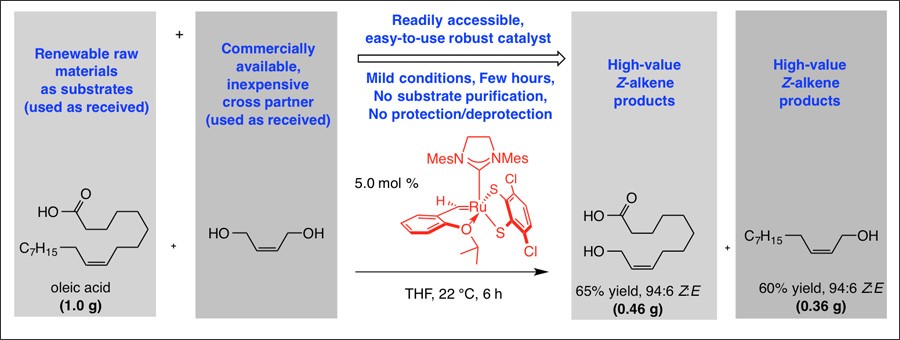
Olefin metathesis provides access to molecules that are indispensible to research in chemistry, biology and medicine. Despite the recent discovery of catalysts that promote Z-selective reactions, an important persisting problem has been the lack of transformations that directly generate acyclic Z allylic alcohols. This shortcoming extends to products that contain a hindered neighboring substituent and/or reactive and ubiquitous functional units such as a phenol, an aldehyde, or a carboxylic acid. In a recent report in the journal Nature (2015, 517, 181–186; doi:10.1038/nature14061) Professor Amir Hoveyda and graduate studens Ming Joo Koh, Kashif Khan, Miao Yu and Malte Mikus together with postdoctoral associate Dr. Sebastian Torker report on the design of a Ru complex that is uniquely effective in generating the aforementioned compounds by cross-metathesis processes. The complex is prepared from a commercially available Ru-based precursor and an easily generated air-stable zinc catechothiolate. Transformations typically proceed with 5.0 mol % of the complex and an inexpensive reaction partner in 4–8 hours under ambient conditions; products are obtained in up to 80% yield and 98:2 Z:E selectivity. Utility is demonstrated by application to synthesis of naturally occurring anti-tumor agent neopeltolide and a single-step stereoselective gram-scale conversion of a renewable feedstock (oleic acid) to an anti-fungal agent.
View the publication in Nature
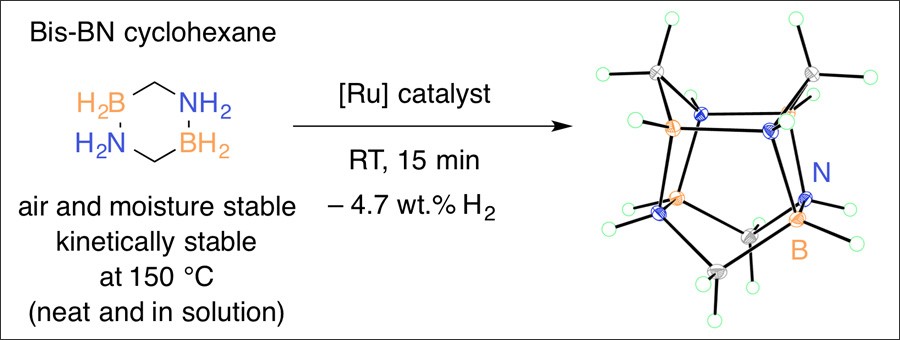
A critical component for the successful development of fuel cell applications is hydrogen storage. For back-up power applications, where long storage periods under extreme temperatures are expected, thermal stability of the storage material is particularly important. In their recent communication from the Journal of the American Chemical Society, Professor Shih-Yuan Liu and his coworkers at Boston College, in collaboration with team members at the Pacific Northwest National Laboratory (PNNL) and The University of Alabama describe the synthesis and characterization of an unusually kinetically stable chemical hydrogen storage material with a H2 storage capacity of 4.7 wt%. The compound, which is the first reported parental BN isostere of cyclohexane featuring two BN units, is thermally stable up to 150 °C both in solution and as a neat material. Yet, it can be activated to rapidly desorb H2 at room temperature in the presence of a catalyst without releasing other detectable volatile contaminants. Furthermore, the team also intercepted and structurally characterized two cage compounds with the unique S4 symmetry that were also formed during the H2 desorption process. The remarkable kinetic stability exhibited by this new compound (a.k.a Bis-BN cyclohexane) and the ability to readily release its stored H2 content under mild conditions would make it a potentially suitable candidate for stationary fuel cell applications. Overall, this work provides a new approach for the development of thermally stable chemical hydrogen storage materials and is establishing the potential for Bis-BN cyclohexane to serve as a monomer for new polymeric architectures.
View the publication in the Journal of the American Chemical Society
2014 Research Highlights
11.24.2014 Shih-Yuan Liu: “Two BN Isosteres of Anthracene: Synthesis and Characterization”
09.18.2014 Amir Hoveyda: “Catalytic Enantioselective Multicomponent Assembly”
09.05.2014 Frank Tsung & Jeff Byers: “Molecular Encapsulation beyond the Aperture Size Limit”
09.05.2014 Frank Tsung: “Surfactant-Directed Atomic to Mesoscale Alignment”
07.29.2014 James Morken: “Organoboron Transformations via Boron-Stabilized Carbanions”
07.15.2014 Udayan Mohanty: “Binding Affinity of p53: A Tumor Suppressor Peptide”
03.03.2014 James Morken: “Sequential Catalytic and Enantioselective Formation of C–B and C–C Bonds”
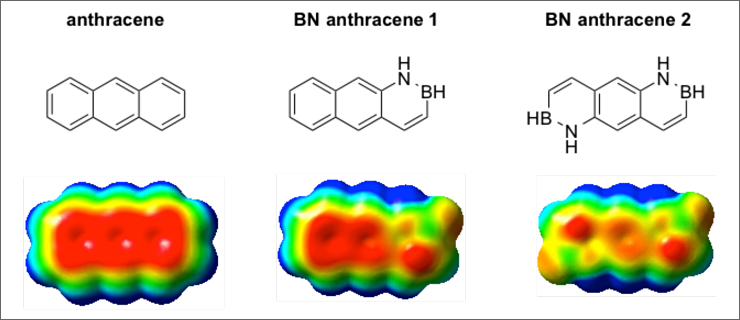
Acenes, or linear benzofused polyaromatics, are a distinct class of polycyclic aromatic hydrocarbons (PAHs) with favorable properties for use in organic materials applications. By replacing an aromatic carbon-carbon bond with an isosteric boron-nitrogen bond (BN/CC isosterism), it is possible to create new chemical space and impart new functions that are distinct from the ones exhibited by corresponding classic carbonaceous PAHs. In their recent article from the Journal of the American Chemical Society, Professor Shih-Yuan Liu and co-workers, in collaboration with the group of Professor Anna Chrostowska (Universitéde Pau et des Pays de l’Adour, France) synthesized two BN isosteres of anthracene, a simple acene containing three fused benzene rings. The authors demonstrate that BN/CC isosterism lowers the energy of the frontier orbitals of the anthracene framework, significantly increasing its stability. This property is important when considering materials for organic optoelectronic materials, since higher acenes often deleteriously react when used in organic electronics under ambient conditions, causing a decrease in performance. Interestingly, the researchers found that despite the changes in frontier orbital energies, the optical properties of the BN anthracenes remain similar to that of the all- carbon anthracene. The work demonstrates that BN/CC isosterism can be used as a molecular design strategy to improve the stability of acene-type structures while maintaining the photophysical characteristics of this important family of compounds.
View the publication in the Journal of the American Chemical Society
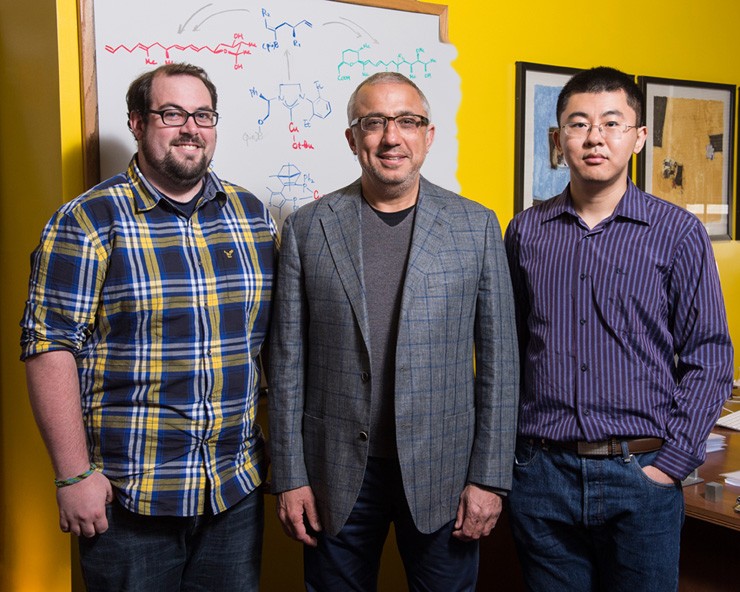
Efficient catalytic reactions that generate C–C bonds enantioselectively and those that produce trisubstituted alkenes diastereoselectively are central to research in modern chemistry. Transformations that accomplish these tasks simultaneously in a single operation are scarce and highly prized; this is particularly the case if the catalysts, substrates and reagents are easily accessed at low cost and reactions are simple to set and conditions are conditions are mild. In an Article in this week’s issue of Nature, Professor Amir Hoveyda and graduate students Fanke Meng and Kevin McGrath report a facile multicomponent catalytic process that begins with a chemo-, site- and diastereoselective copper–boron addition to a monosubstituted allene. The resulting boron-substituted organocopper intermediates then participate in a chemo-, site- and enantioselective allylic substitution. Products, which contain a stereogenic carbon center, a mono-substituted alkene and an easily modifiable Z-trisubstituted alkenylboron group, are obtained in up to 89% yield, with >98% branch- and stereoselectivity and >99:1 enantiomeric ratio. The copper-based catalyst is derived from a robust heterocyclic salt that can be prepared in multi-gram quantities from inexpensive starting materials and without costly purification procedures. Utility of the approach is showcased through exceptionally concise enantioselective synthesis of gram quantities of natural products rottnestol (member of an antibiotic family) and herboxidiene (anti-tumor). In the case of rottnestol, the overall yield is seven times better than the best formerly reported approach, and herboxidiene is accessed in nearly twice the total yield of the most efficient previous route.
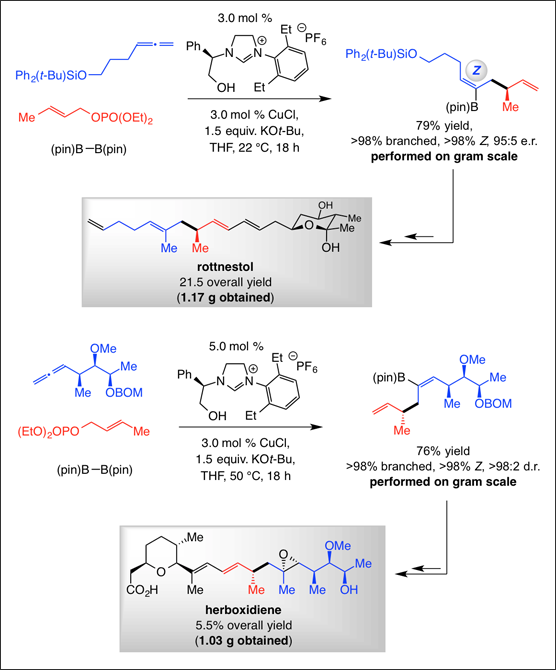
Read the article in Nature
A discussion on the significance of the paper's findings by Professor Phil S. Baran and graduate student Matthew T. Villaume, Scripps Research Institute, appears in Nature: News and Views
To read other accounts of this work, go to: Chemical & Engineering News
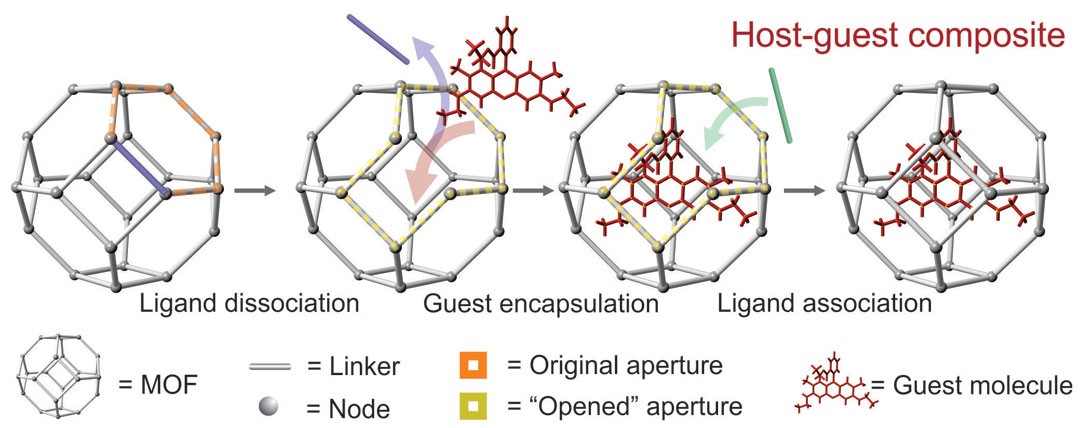
Incorporating functional guest molecules into the cavities of crystalline porous materials makes it possible to engineer these materials for drug delivery, sensing, electrical conductivity, luminescence, and energy conversion. Recently, attention has been drawn to a molecular-type class of crystalline porous materials, metal-organic frameworks (MOFs) due to their chemically tunable pore surfaces, their comparatively mild syntheses, and their unique properties such as framework flexibility, postsynthetic modification, and exchangeable ligands. Despite these advances, approaches for incorporating large and more diverse guests into MOFs are still limited. In a recent report in the Journal of the American Chemical Society, a team led by Professors Frank Tsung and Jeff Byers introduce a new concept for incorporating larger and more diverse guest molecules into MOFs. In this approach, they take advantage of ligand exchange reactions to “open” part of the framework of the pre-synthesized MOF crystals. Expanded apertures created by the ligand exchange process allow large guest molecules to diffuse into the MOF pore. After guest incorporation, association of the ligand closes the large aperture, trapping the guest molecule in the MOF pore. This new approach to guest incorporation is expected to be general because framework ligand exchange has been carried out under various conditions and exists in a large number of MOFs with diverse secondary building units. An additional practical advantage of decoupling encapsulation and MOF synthesis is that MOF production can be scaled-up independently of guest loading, which is especially relevant since several MOFs, such as ZIF-8, Fe-BTC, HKUST-1, and MIL-53(Al), have been become commercially available.
View the publication in the Journal of the American Chemical Society
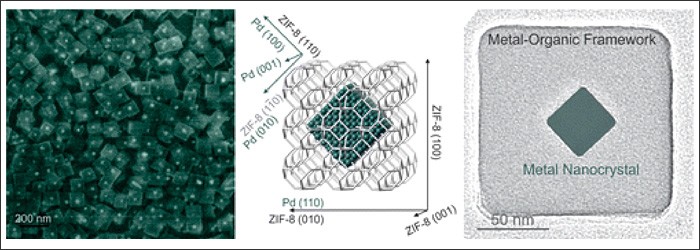
In colloidal syntheses, it is a challenge to control the lattice alignment at the interface between materials with crystal lattices in disparate scales, such as those between metal lattices and microporous or mesoporous materials, where the structural parameters can differ by orders of magnitude; however, the alignment is highly desired for many applications. In a recent report in the Journal of the American Chemical Society, Professor Frank Tsung and coworkers address this challenge by a new concept inspired by studies on self-assembled monolayers (SAM). By using self-assembled surfactant layers, they have aligned the lattices at the interface in a proof-of-concept structure, a core-shell nanocomposite with a well-defined metal nanocrystal core and a metal-organic-framework (MOF) shell. This system is representative because the metal and MOF lattices differ in structural dimensions by orders of magnitude. This is the first example of utilizing self-assembled molecules in colloidal syntheses to align crystalline materials from the atomic scale to the mesoscale. The alignment is essential for follow-up studies on the diffusion and orientation of molecules in such structures which will be investigated via spectroscopic analysis and catalysis experiments.
View the publication in the Journal of the American Chemical Society
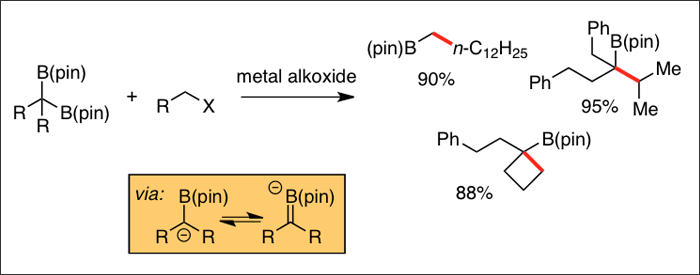
Organoboron compounds can be readily converted to a range of valuable products and are thus widely used in chemical synthesis. A pressing issue in modern organic chemistry, therefore, relates to the development of protocols that furnish access to these entities, particularly if readily available and previously unutilized starting materials can be employed. In a recent report in the Journal of the American Chemical Society, Professor James Morken and co-workers outline precisely one versatile instance of such a transformation. The newly developed strategy involves the alkoxide-promoted reaction of 1,1-bis(pinacolboronate) esters with alkyl halides by a pathway that results in the deletion of one of the two geminal boryl units, followed by C–C bond formation of the resulting boron-stabilized carbanion with an electrophile. The process can be accomplished easily on preparative scale (for example, >5 grams), is broadly applicable, and can be accomplished intramolecularly to furnish cyclic products. Mechanistic investigations through the use of 13C- and 10B-labeled compounds support the contention that transformations occur via boron-stabilized carbanions, likely stabilized by π-bonding between the carbanion and the remaining boron (B=C bonding). The research carried out in the Morken laboratories was funded by a grant from the National Institutes of Health.
View the publication in the Journal of the American Chemical Society
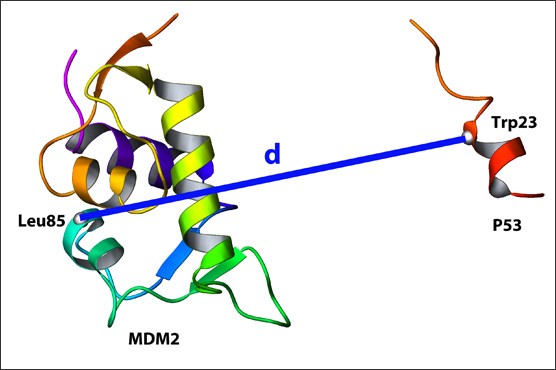
The transcription factor p53 commences arrest of the natural cell cycle in response to DNA damage. The p53 peptide, like other short peptide segments of a protein, is found to be in disordered states in solution and therefore is not able to maintain proper interactions for binding. Stabilization of the 16-residue helical domain in p53 was previously accomplished by introducing an all-hydrocarbon tether of different lengths and stereochemistry. This stapled version of the p53 peptide was shown to slow the growth of cancer cells in vivo by activating the p53-mediated apoptotic paths.
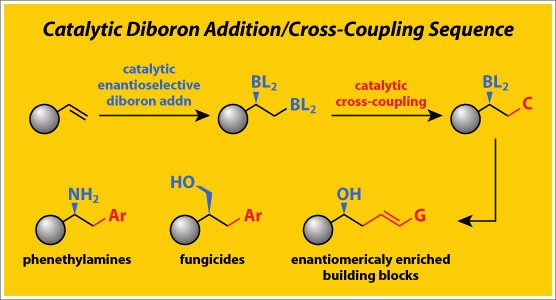
Terminal alkenes are among the most desirable starting materials in organic synthesis: they are manufactured on enormous scale and can be used in countless transformations. While their latent reactivity readily lends itself to hydrocarbon chain extension, alkenes have the attractive feature of being stable to many acids, bases, oxidants and reductants. Despite such attractive attributes, catalytic enantioselective transformations that utilize mono-substituted alkenes and proceed in high enantioselectivity (e.g., 95:5 enantiomer ratio or better) are scarce. In a recent publication in Nature, Professor James Morken along with senior graduate students Scott Mlynarski and Chris Schuster, outline a remarkable single-flask catalytic enantioselective process that transforms terminal alkenes into a range of useful and valuable products in high enantiomeric purity. The BC approach involves an all-catalytic sequence that includes a diboron addition and is followed by a regioselective cross-coupling to generate a C–C bond. A large assortment of otherwise difficult-to-access products can thus be generated in >95:5 enantiomer ratio by reactions that are promoted by no more than 1-2 mol % of commercially available catalysts and reagents.
Read the article in Nature
2013 Research Highlights
10.08.2013 Dunwei Wang: “Surface Modification Increases Photovoltage Generation by "Rust" By Over 100%”
08.13.2013 Amir Hoveyda and Marc Snapper: “Enantioselective silyl protection of alcohols”
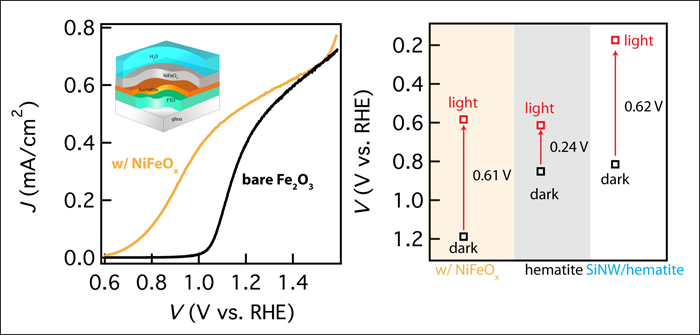
Artificial photosynthesis seeks to harvest solar energy and directly convert it into chemical energy for easy storage and redistribution. In developing technologies to meet this goal, scientists face an important challenge that photoelectrodes often fail to generate enough voltage to power desired chemical reactions, such as the splitting of water into molecular oxygen and hydrogen. The challenge is probably best manifested by a prototypical material, hematite (α-Fe2O3), which can only produce 0.3 V power while its bandgap is >2 V. Professor Dunwei Wang and his team show that the issue can be mitigated by a simple surface modification. Using a recently identified oxygen evolution catalyst, the Wang group succeeded in measuring a photovoltage of 0.61 V (or an increase of 100%) on hematite. As a result, a record-low turn-on voltage of 0.62 V (vs. reversible hydrogen electrode) was observed. When combined with silicon nanowire dual absorbers, the turn-on potential was further reduced to 0.32 V (corresponding to a photovoltage of 0.91 V). These data, published in Angewendte Chemie International Edition, represent a new benchmark for the hematite-based solar water splitting reactions. Most significantly, the team considers the cause of the cathodic shift a result of improved thermodynamics, a dramatic deviation from previous views that such a shift would be a result of kinetic changes. The conclusion is supported by their photovoltage measurements under open circuit conditions where the influence of kinetic factors is nonexistent. The result renews the hope of using hematite, an earth abundant, inexpensive, and stable material, for practical artificial photosynthesis. This research was supported financially by the National Science Foundation and the Alfred P. Sloan Foundation.
Read the article in Angewendte Chemie International Edition
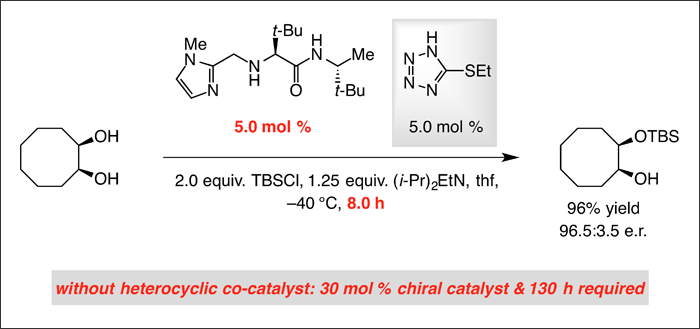
In Nature Chemistry, Professors Amir Hoveyda and Marc Snapper and their coworkers describe and demonstrate a counterintuitive strategy for dramatically accelerating the catalytic enantioselective monosilylations of diols and polyols to furnish valuable alcohol-containing molecules in high enantiomeric purity. In the past, such transformations typically required high catalyst loadings (20–30 mol%) and long reaction times (2–5 days). The team’s new strategy involves the addition of an achiral co-catalyst that is structurally similar to the chiral catalyst, which effectively solves the problem. The key discovery is that a combination of seemingly competitive organic bases can function in concert, such that one serves as an achiral nucleophilic promoter while the other performs as a chiral Brønsted base. On the addition of 7.5–20 mol% of a commercially available N-heterocycle (5-ethylthiotetrazole), reactions typically proceed within one hour and deliver the desired products in high yields and high enantiomeric ratios. In some instances, there is no reaction at all in the absence of the achiral base, yet addition of the achiral co-catalyst gives rise to facile formation of products in high enantiomeric purity. The principles outlined in this paper serve as a conceptual framework for the development of new processes that demand separate and independently operational Lewis basic co-catalysts whose functions can easily overlap and the simultaneous use of which might initially appear to be detrimental towards achieving high enantioselectivity. This research was supported financially by the National Institutes of Health.
Read the article in Nature Chemistry
Read the BC News Release

